
Guide dogs are assistance dogs trained to lead blind or visually impaired people around obstacles. Although dogs can be trained to navigate various obstacles, they are red–green colour blind and incapable of interpreting street signs. The human does the directing, based on skills acquired through previous mobility training. The handler might be likened to an aircraft's navigator, who must know how to get from one place to another, and the dog is the pilot, who gets them there safely. In several countries guide dogs, along with most other service and hearing dogs, are exempt from regulations against the presence of animals in places such as restaurants and public transportation.

The Labrador Retriever or simply Labrador is a British breed of retriever gun dog. It was developed in the United Kingdom from fishing dogs imported from the colony of Newfoundland, and was named after the Labrador region of that colony. It is among the most commonly kept dogs in several countries, particularly in the Western world.

The Border Collie is a Scottish breed of herding dog of medium size. Widely considered to be the most intelligent dog breed, they are descended from landrace sheepdogs once found all over the British Isles, but became standardised in the Anglo-Scottish border region. They are now mostly used as working dogs to herd livestock, specifically sheep.

The Australian Cattle Dog (ACD), or simply Cattle Dog, is a breed of herding dog originally developed in Australia for droving cattle over long distances across rough terrain. This breed is a medium-sized, short-coated dog that occurs in two main colour forms. It has either red or black hair distributed fairly evenly through a white coat, which gives the appearance of a "red" or "blue" dog.

A Labradoodle is a crossbreed dog created by crossing a Labrador Retriever and a Standard, Miniature, or Toy Poodle. The term first appeared in 1955, but was unpopular. Labradoodles are considered a good choice for people with canine dander allergies, since some have the same hypoallergenic coat as their poodle ancestors.

A herding dog, also known as a stock dog, shepherd dog, sheep dog or working dog, is a type of dog that either has been trained in herding or belongs to breeds that are developed for herding.
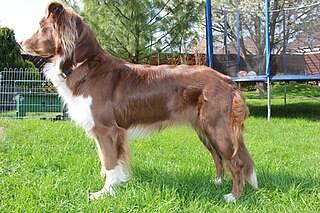
The Australian Shepherd is a breed of herding dog from the United States. The name of the breed is technically a misnomer, as it was developed in California in the 19th century; the breed was unknown in Australia at the time. It is claimed that Australian Shepherds descend from a variety of herding breeds, including collies imported, alongside sheep, from Australia and New Zealand; the breed reportedly took its name from this trade. Originally used solely as a herding dog, the Australian Shepherd has become one of the most popular companion dog breeds in North America.
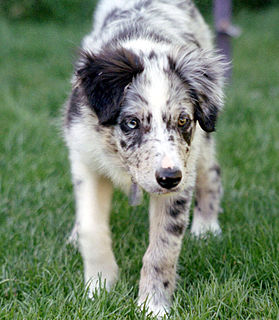
Merle is a genetic pattern that can be in a dog's coat. Merle comes in different colors and patterns and can affect all coat colors. The merle gene creates mottled patches of color in a solid or piebald coat, blue or odd-colored eyes, and can affect skin pigment as well. There are two general types of colored patches that will appear in a merle coat: liver and black. Some breeds that can be affected by this genetic trait are Carea Leonés, Australian Shepherds and Catahoula Leopard Dogs. This genetic trait should be taken seriously when breeding merles. Health issues are more typical and more severe when two merles are bred together, so it is recommended that a merle be bred with a non-merle dog of any other color.

Dorothy Leib Harrison Wood Eustis was an American dog breeder and philanthropist, who founded The Seeing Eye, the first dog guide school for the blind in the United States. She was inducted into the National Women's Hall of Fame in 2011.
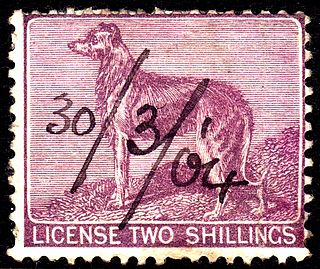
A dog licence is required in some jurisdictions to be the keeper of a dog. Usually a dog-licence identifying number is issued to the owner, along with a dog tag bearing the identifier and a contact number for the registering organization. If a stray pet is found with the tag, a rescuer can call the registering organization to get current contact information for the animal.
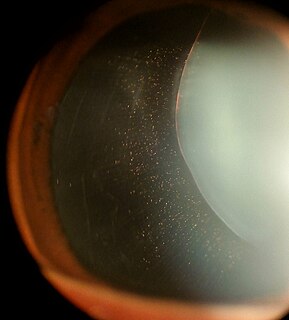
Ectopia lentis is a displacement or malposition of the eye's crystalline lens from its normal location. A partial dislocation of a lens is termed lens subluxation or subluxated lens; a complete dislocation of a lens is termed lens luxation or luxated lens.

The Lonja de la Seda or Llotja de la Seda is a late Valencian Gothic-style civil building in Valencia, Spain. It is a principal tourist attraction in the city.

Troy Selwood is a former Australian rules footballer who played 75 games for the Brisbane Lions in the Australian Football League (AFL). He was also captain of the Geelong Football Club's team in the Victorian Football League (VFL) from 2011 to 2013.

Leader Dogs for the Blind is a guide dog training organization located in Rochester Hills, Michigan. It was founded in 1939 by Lions Club members Charles Nutting, Don Schuur and S.A. Dodge, as the second guide dog organization founded in the United States and has paired over 14,500 dogs with the visually impaired worldwide, making it one of the largest organizations of its kind.
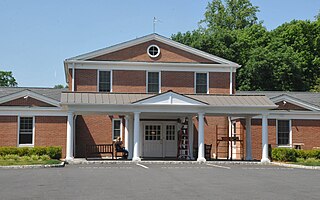
The Seeing Eye, Inc. is a guide dog school located in Morristown, New Jersey, in the United States. Founded in 1929, the Seeing Eye is the oldest guide dog school in the U.S., and one of the largest. The Seeing Eye campus includes administrative offices, dormitory residence for students, a veterinary care center, and kennels; there is also a breeding station in Chester, NJ. The Seeing Eye, a founding member of the U.S. Council of Guide Dog Schools and a fully accredited member of the International Guide Dog Federation, is a lead researcher in canine genetics, breeding, disease control, and behavior.

The Shar Pei is a dog breed from southern China. Traditionally kept as a property guardian, the Shar Pei was driven to the brink of extinction in the 20th century. The breed is known in the West for its deep wrinkles, whilst a traditional less wrinkled form is maintained in Hong Kong.
Seda or SEDA may refer to:

Vision Australia is a not-for-profit organisation and Australia's largest provider of services for people with blindness and low vision.

Morris Frank was a co-founder of The Seeing Eye, the first guide-dog school in the United States. He traveled the United States and Canada to promote the use of guide dogs for people who are blind or visually impaired, as well as the right of people with guide dogs to access restaurants, hotels, transportation, and other places that are open to the general public.


















